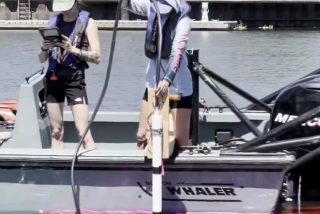Tiny Glowworms Could Help Detect Water Pollution
- Share via
ATLANTA — A scientist watches a tiny animal’s glitter fade when its water is contaminated. He hopes that he has found a quicker and cheaper way to measure pollution.
“If a test is simple and inexpensive, like testing water with these rotifers is, then you can do more tests,” said Terry Snell, a biology professor at Georgia Tech. “The more tests you do, the more you know about toxicity in the water, and we do need to know more.”
Rotifers are microscopic aquatic organisms whose bodily functions slow down when they are exposed to toxic substances. Snell turns them into a type of aquatic glowworm by feeding them fluorescent beads. Then he watches their systems slow--as the glow fades--when they find toxics in their water.
He says his method is up to five days faster and several dozen times cheaper than the one the Environmental Protection Agency uses.
He is trying to make it even faster by breeding rotifers with the fluorescent gene of a firefly so he won’t have to feed them to make them glow.
“It’s got to be faster, cheaper, but just as reliable,” Snell said.
His experiments show promise, particularly if he can breed the rotifer to glow, said Don Versteeg, a research scientist for Procter & Gamble Co. in Cincinnati.
Other scientists have measured toxicity with fluorescent bacteria, but using a rotifer “is much more ecologically relevant,” Versteeg said. “It would be a major advance because instead of looking at bacteria, you’d look at an animal.”
“We need cheaper ways to determine toxicity,” said James H. Finger, director of southeast environmental services for the EPA. “Anybody that’s got a method, we will look at it.”
The EPA measures toxicity by tracking the reproductive rate and mortality of other tiny water animals, such as the cladoceran, a microscopic crustacean.
But these tests cost $1,000 to $1,500 each, mostly because it takes about seven days to observe them reproducing and dying.
Snell measures the ingestion rates and enzyme activities of rotifers over two days. He said his tests are much cheaper--although he wouldn’t name a specific cost--because they are faster.
Rotifers, which eat algae, live in freshwater and saltwater and are an important part of the food chain: Small fish and crabs eat them. The volume and speed at which they digest food is an indicator of their reproduction and mortality rates, Snell said.
He measures the ingestion rate with the glowing beads he feeds them; the intensity of their glow lets him know how much they ate.
Snell also tracks the activity of enzymes, proteins in the body that break down food, by measuring how long the rotifers glow. As toxics slow the enzyme activity, the glow fades.
Snell’s work is only beginning.
“What we have been working on are a whole battery of organisms representing different levels in the food chain, from algae and protozoa all the way up to fish,” he said. “Then we’ll have a broader screen to know that maybe the animals aren’t being affected but the plants are getting blasted.”
But he will have to prove that his tests accurately predict reproductive slowing and mortality, Versteeg said.
“It all depends on how good that correlation is,” Versteeg said. “But with additional research this is the whole direction the field is going in--quicker ways to say how we’re going to be affecting populations long term.”
More to Read
Sign up for Essential California
The most important California stories and recommendations in your inbox every morning.
You may occasionally receive promotional content from the Los Angeles Times.











